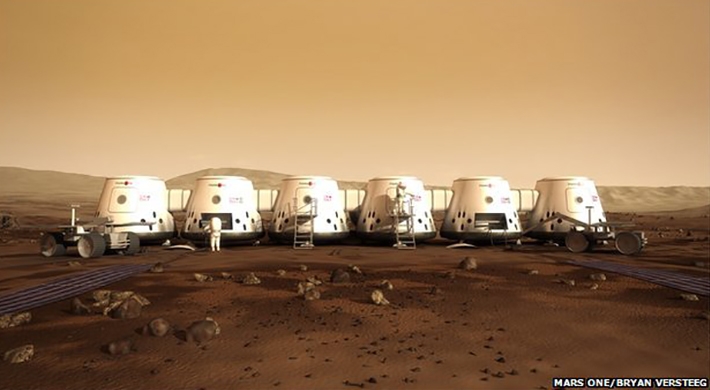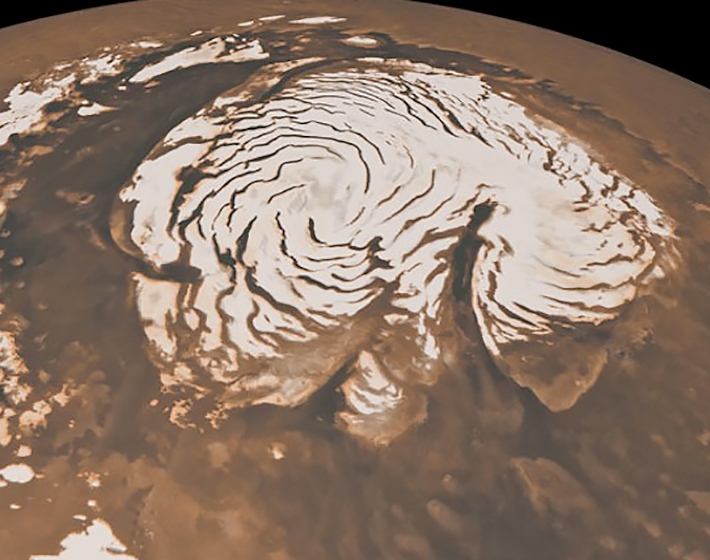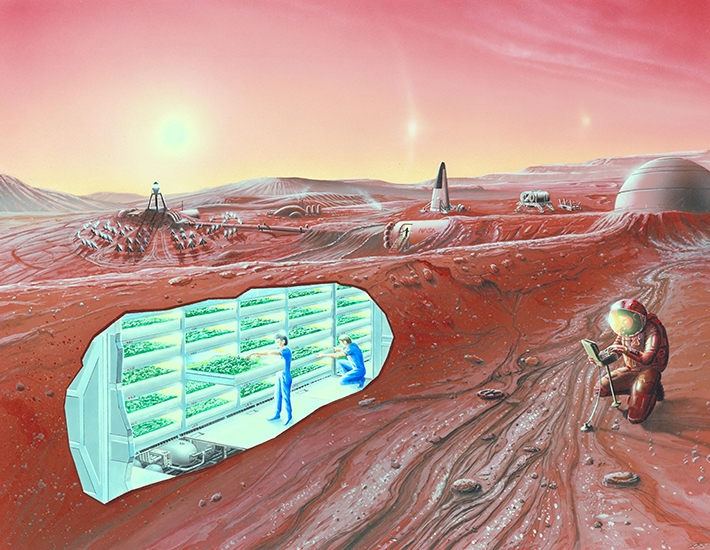Dutch Project 'Mars One' has gained media attention recently for its ambitious plans to colonise Mars in just under a decade's time. On the 11th Jan this year, it was announced that 3 Britons had made the shortlist of just over 1,000 people who had applied to be one of the first human settlers on Mars. This shortlist will eventually be whittled down to just 24 people from across the globe, who will embark upon a 7-year training course to help them adapt to the psychological and social aspects of living in the small, isolated community. 'Mars One' is a private initiative and relies on sponsorship for funding. Opinions range from the assumption that a project so vital to the development of humankind couldn't fail to raise the funding required, to those who believe the project is not convincing enough to achieve appropriate funding and so is doomed to failure. The confidence with which the schedule for 'Mars One' has been presented would suggest that it is a proved scientific possibility, though there are a number of issues to consider before putting complete faith in the 'Mars One' project.
Some aspects of Martian geography make it appealing as a possible site of colonisation. For example, the solar day on Mars is 24 hours, 39 minutes and 35.244 seconds long, not far from the length of the solar day on Earth. Settlers would not find the difference difficult to adapt to. The seasons are also similar to those experienced on Earth, as Mars has an axial tilt of 25.19° (for comparison with Earth's axial tilt of 23.44°). However, the Martian year lasts about 1.88 Earth years, so the seasons last nearly twice as long on Mars as they do on Earth.
But what about Venus? Venus is closer to Earth, is similar in bulk composition and even has a similar size and surface gravity. However, it has a dense atmosphere, an enormous surface atmospheric pressure 92 times that of Earth's and a mean surface temperature of 435K (162°C), caused by a runaway Greenhouse Effect. It is a truly inhospitable environment.
Despite some astronomical similarities to Earth, Mars remains almost as inhospitable to life as Venus. Like Venus, it has an atmosphere dense with 95% carbon dioxide, and oxygen totals less than 0.4%. The partial pressure of carbon dioxide is 7.1 mbar, making the air toxic to plants and animals. For comparison, carbon dioxide poisoning in humans begins at about 1 mbar and at 1.5 mbar for plants. It is believed that Earth and Mars once had similar atmospheres, but developed very differently. (This suggests that Mars may contain valuable mineral ores and may have the potential to sustain life.) There is evidence that Mars was once covered in oceans of water and so must have had a more substantial atmosphere at some point. Currently the atmosphere is very thin and it is not capable of stopping heat from the Sun from escaping into Space. Combined with its increased distance from the Sun, this results in a very cold planet. Whereas Venus is extremely hot, Mars has a mean surface temperature of between 186K and 268K (-87°C and -5°C). The Concordia Station in Antarctica is the environment closest on Earth to simulating the conditions on the surface of Mars, in terms of temperature. It is used to study how humans may survive a trip to the Red Planet.

Two living units, others for food and emergency supplies.
Credit: Bryan Versteeg
The thin atmosphere holds further complications for colonisation. The Armstrong limit for atmospheric pressure is 61.8 mbar; below this level, human beings are not able to survive without pressure suits. The atmospheric pressure on Mars is around 7.5 mbar, considerably lower than the Armstrong limit. This would mean that any colonisers of Mars would have to live in pressure vessels providing life support, unless terraforming is successful in increasing the atmospheric pressure. The thin atmosphere is the result of solar wind stripping the atmosphere away. (This does not happen to Earth because it's protected by a strong magnetic field.) As the atmosphere is so thin, there is nothing to stop the Sun's high energy particles from reaching the surface of Mars. The Mars Radiation Environment Experiment (MARIE) found average doses of radiation in orbit were about 22 millirads a day. Just three years of exposure to these levels would be close to the safety limits currently adopted by NASA. Of course, levels of radiation would be lower on the surface of the planet, but this radiation risk is another high risk factor for potential colonisers, as it could result in lowered immune systems, infertility and cancer. Living quarters would need to be built underground to reduce the radiation exposure for Martian colonisers.
One other crucial consideration for settlers on Mars is that the mission is a one-way trip. Over the course of the 7-8 month journey to Mars, the colonisers would lose bone and muscle mass as a result of the lowered force of gravity. This would continue on the planet, as the gravity on Mars is around 1/3 of that on Earth. Travellers would be unable to return after such an ordeal, as their bodies would not be able to readjust to Earth's much stronger force of gravity. The problems facing potential settlers on Mars are geographical, physical, biological, social and psychological, and there is much evidence to be gathered to judge whether a colonisation on Mars is at all a possibility in the near future. This is a subject covered in many novels of the 20th century, and perhaps they can be used as inspiration to find solutions to the problems facing potential settlers on Mars and perhaps they can shed light on any further complications that are likely to arise.
"I would like to die on Mars. Just not on impact." Elon Musk
Around the turn of the century, a number of prominent scientists put forward the idea that Mars was inhabited by intelligent life. This sparked the imagination of SF writers, and what followed was an overload of Martians in fiction, usually highly intelligent and a posing a terrifying threat to humankind on Earth. The common portrayal of Mars was of a desert planet with giant canals built by an ancient civilisation to bring water from the polar ice caps. The general feeling was that there possibly existed, in the near vicinity, a race far older and more developed than that of humankind. The Martians were a powerful adversary and we would make attempts to colonise at our peril.
Ray Bradbury's 'The Martian Chronicles,' published in 1950, reflects such notions about life on the Red Planet by depicting humankind's flight to Mars following the devastation of Earth by nuclear war. The colonisers find an aboriginal Martian settlement and Bradbury's stories relate the conflicts between the native inhabitants and the human colonists. It is interesting to see what obstacles were expected to arise in the attempt to colonise Mars, as Bradbury wrote in a time when very little was known about the conditions on Mars and the planet's potential to harbour life. Bradbury's human settlers attempt to build houses like those in American towns on Earth, though the reality is that their living arrangements would be far more restrictive than those on Earth and most likely, underground to protect the inhabitants from radiation. One of the settlers, Driscoll, plants seeds to grow oxygen-producing trees, in an attempt to make the Martian atmosphere easier to breathe. Bradbury notes that the composition of the atmosphere would be different on Mars and that this would have an impact on human's ability to respire. However, he was unaware of quite how inhospitable to human life the Martian atmosphere actually is. As mentioned earlier in the article, the partial pressure of carbon dioxide makes Martian air highly toxic for both animals and plants. Humans, plants and animals would not be able to breathe the air at all unless terraforming altered the atmospheric composition sufficiently. If the levels of oxygen in the atmosphere could be brought over the threshold for plants to survive, then oxygen-producing plants would indeed be useful in lowering the level of carbon dioxide and increasing the levels of oxygen in the air.
Terraforming is a hypothetical process by which climate, surface and known properties are altered to make an environment more hospitable to human habitation. Such alterations of the Martian environment would include building an atmosphere, making it richer in oxygen, keeping the planet surface warm and preventing the atmosphere from being lost to outer space. The high levels of carbon dioxide in the Martian atmosphere would be beneficial to trap thermal energy near the surface, aiding much-needed global warming.

Spiral troughs and giant canyon, 'Chasma Borale' in the North Polar ice cap on Mars.
Credit: NASA
It could be argued that humankind's mere presence on Mars would be an example of terraforming. Living on Mars would require a number of facilities that would have an inevitable impact on the local environment, and possibly the whole planet. Settlers would need access to water, food, space to build, construction materials, energy, transportation, communications, life support, simulated gravity and radiation protection. The Martian North Pole ice cap is a potential source for liquid water, though higher temperatures and increased pressures would need to be in place to keep it in liquid form. Martians would need somewhere to grow their own food, though they'd experience a replenishing of emergency rations every two years as new settlers move in. Human waste would need to be recycled while settlers are living in the planned living units. This would require apparatus similar to that on the International Space Station, though comment has been made of the frequency at which this apparatus needs maintenance and questions raised about how long the technology would be a sustainable solution on the Martian surface.
In isolation of Earth's systems, the settlers on Mars would need an independent and reliable source of fuel. The ice caps in the Martian geology, in addition to providing a source of liquid water, can be used to making effective fuel. Settlers would need to bury through the icy surface to release liquid water and steam. Electrolysis could be used to pull the hydrogen and oxygen ions apart, resulting in a supply of the two elements in gaseous form. Hydrogen can react with carbon dioxide, of which the Martian atmosphere is rich, to produce methane. Methane can be reacted with a supply of oxygen to produce a most powerful reaction that could be used to fuel transport and other operations. Other potential sources of energy on Mars include solar power and nuclear power. Solar insolation is only 42% of that on Earth, but Mars makes up for this with its thin atmosphere, which allows almost all of that solar energy to reach the planet's surface. Nuclear power has the benefit of providing very dense fuel that is easy to transport and of producing heat, which would be very welcome on the icy planet. Mars may prove itself a vital base for exploration of other parts of space. It could be used to grow food and produce equipment, fuel and resources for miners in the asteroid belt.
Conceived much later than Bradbury's fictional universe, Kim Stanley Robinson's 'Mars Trilogy' identifies the strong need for terraforming if Mars is to be made more hospitable to human life. The atmosphere is thickened using a bio-chemical formula named as the 'Russell Cocktail', after one of the lead characters. The planet is successfully heated through the drilling of 'moholes' that release heat from beneath the surface. Water is released through nuclear explosions in the planet's sub-surface permafrost.
The titles of the novels in the trilogy reflect the stages of terraforming on the way to making Mars a hospitable place for human beings. By 'Green Mars,' terraforming has successfully allowed plants to grow on the surface of the planet, through the genetic modification of algae, lichen and bacteria, to convert the atmosphere into breathable air. This genetic engineering could be extended to animals and humans, to help them better withstand life in the thinner atmosphere. Further modifications may include the ability to see better in the dim light of the outer planets. Robinson's characters also eventually have their longevity improved, and this results in psychological effects explored within the plot of the novel.

Terraforming: Growing plants on Mars.
'Blue Mars' presents a depiction of the Red Planet in a very late stage of terraforming, as atmospheric pressure and temperature increases have allowed the existence of liquid water on the surface. By now, with improved technological and scientific abilities, humankind is in a position to relieve the population strain on Mars by spreading through the solar system, beginning with the creation of cities on nearby asteroids.
Robinson's characters raise debate about the ethics of terraforming throughout the novel series. Some are seen to hold the 'Green' position, which supports terraforming activities and prides itself on appreciating and encouraging the continuation of life. They believe that humans have an obligation to spread life in the universe as it is so scarce. In opposition to this is the 'Red' position, which maintains that humankind does not have the right to change the ecology of the planets it settles upon. The novels also raise another important question: should the colonisers of Mars be subject to Earth's authority, culture, traditions, etc., or should they try to develop these things independent of their home planet?
The pieces of fiction featured have introduced ecological disaster, nuclear war and overpopulation as reasons for humans to leave Earth and set up a colony on Mars. The fear that Earth will at some point no longer be habitable pervades these texts: the fear that we will inevitably out-grow our world, it will let us down or we will destroy it ourselves. We need to find alternative living spaces to also relieve the pressure of overpopulation on Earth and to help preserve the environment on our home planet. This need to ensure the survival of the human species is just one of the reasons cited for the colonisation of other planets. The commercialisation of space offers money-making opportunities: solar-power satellites, mining of rare materials and manufacturing space. Many believe that it satisfies our insatiable curiosity and our need to explore and understand our environment. These reasons, and many more, offer motivation for the many applicants to the 'Mars One' programme, who want to experience an opportunity truly out-of-this-world.
True to the nature of science fiction to explore and speculate, and also to show how fictional scenarios may shed light on contemporary events, Robinson notes that "Space science is an earth science, where studying Mars is part of understanding Earth as a planet, with scientific, philosophical or psychological value." Even if the 'Mars One' project is declared not feasible or is postponed until Earth's technology is better prepared for such a venture, the study into the conditions on Mars and its habitability can only serve to help us understand better our own planet, and perhaps appreciate better its rare ability to host life.
References & Further Reading
- Bradbury, "The Martian Chronicles", Doubleday (1950).
- Robinson, "Mars Trilogy", Spectra/Bantam Del/Random House (1994).
Listing image: NASA
